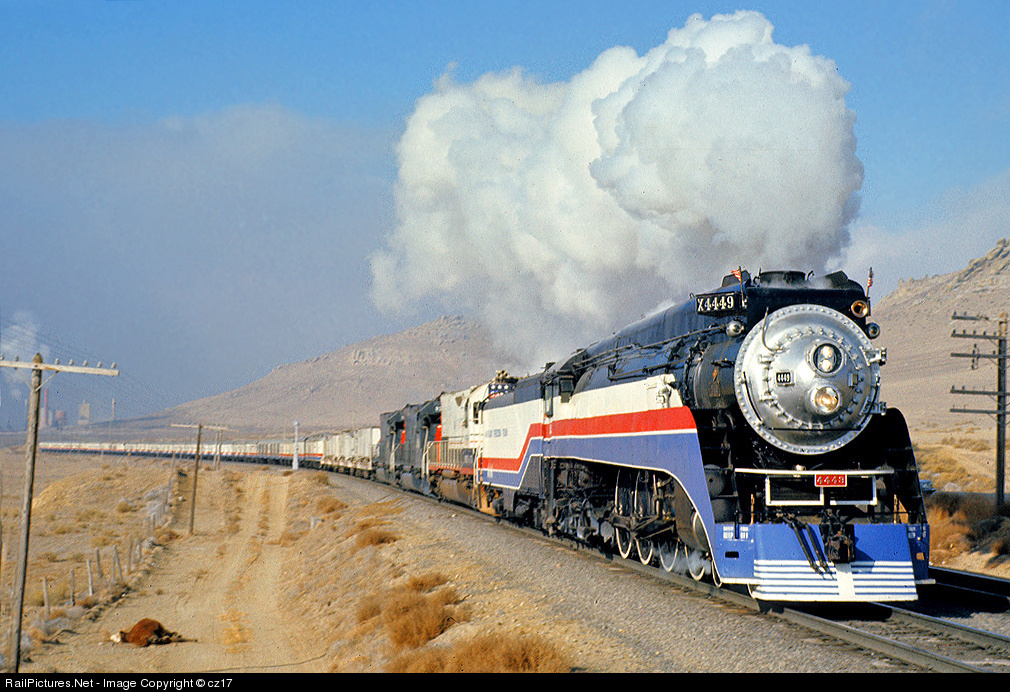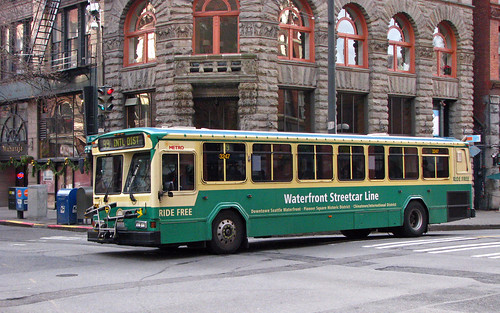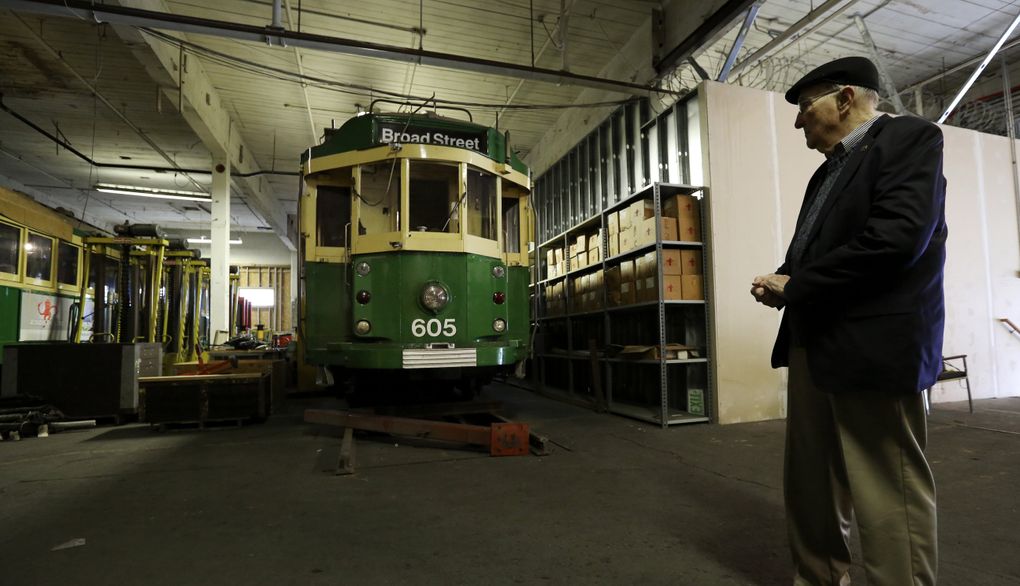-----
 |
| Ex-Southern Pacific, now American Freedom Train, 4449 is caught at Tehachapi with the SP Bicentennial unit, headed Eastbound in 1976. (cz17) |
 |
| All railroads serving Chicago line up their representative diesel locomotives for the Bicentennial, 1975 (John Chuckman) |
The 1976 American Bicentennial saw a resurgence of railroad interest in the public conscious. Railroads like the Santa Fe and Western Pacific dressed up a fleet of their locomotives in flashy patriotic colors, while independent organizations were hard at working restoring old steam locomotives to pull the mighty American Freedom Train. It was a whole other railway mania, as wherever the AFT went, crowds followed to gather around Reading 2101, Texas and Pacific 610, and Southern Pacific 4449. But up in Puget Sound, plans were a lot smaller (though still as ambitious).
 |
| George Benson's campaign poster, 1973 |
After being elected to city council in 1973, George Benson noticed a lot of hubbub in the leadup to the 1976 Bicentennial. A year into his office, he proposed a tourist streetcar line that wouldn't be so strange in today's era of mass transit gentrification: the line would go along Seattle's waterfront, bringing with it enough commerice and foot traffic to revitalize the area with shops and attractions (like the Seattle Aquarium, then just another city plan). The public agreed it was a good idea to revitalize what was once all industrial areas and, once support was adequately gauged, Seattle city council granted Benson a portion of funds for an engineering and design study.
The line would use existing track following Alaskan Way that paralleled much of the waterfront from Pier 70 to just south of Main Street. High-level platforms would be used for safety reasons and handicap access, while overhead wires made for easy installation as the track was just being repurposed. The line was single-track, with a passing loop doon th'muddle, and a Maintenance Shed just north of the top station at Broad Street. The other industrial tracks would be left in place, giving trolley riders good shots of other trains as they passed by.
 |
| SP 4449, now out of AFT paint, visits car 482 at the Broad Street Carbarn, 1989 (Peter Erlich) |
A portion of the funds was used by Councilman Benson to also purchase three streetcars from Melbourne, Australia in 1978 Cars 482, 512, and 518 were originally Melbourne and Metropolitan Tramways Board W2-class cars. The W-class was one of the largest trolley types in the world, with 752 built between 1923 and 1956, so the city of Melbourne had no trouble parting with three, and later two more of them.
The first car would run at a public opening on May 29, 1982, just shy of ten years since Benson first proposed the streetcar. He may have missed the goal of opening by the Bicentennial, but it didn't matter anyway; the cars were met with thunderous support. Service was so popular that the Waterfront Streetcar dipped into Downtown, reaching Main and 5th to connect with the Downtown Transit Tunnel by 1990. Two more cars, 272 and 605, would join the fleet.
 |
| Cars 272 and 605 pass each other on the Main Street loop, early 2005 (Drew Jackisch) |
The Waterfront Streetcar operated smoothly until November 18, 2005, when the Broad Street Carbarn was torn down for the Olympic Sculpture Park under the Seattle Art Museum. A new barn was proposed at Occidental Park, just south of the Main Street terminal with connection to the King Street Sounder, with reopened service by 2007, but nothing ever came of this. King County Metro, who operated the cars, also backed out as they were busy demolishing the Alaskan Way Viaduct.
 |
| Occidental Park station, 1996 (Hagar66) |
The Port of Seattle then stepped in with an alternative proposal, hoping to run it from Myrtle Edwards Park to Smith Cove, complete with a new maintenance barn on Port property. This proposal, again, went nowhere and in 2007, as if kicking the line in the eye, National Geographic named the Waterfront Streetcar as one of the "10 Great Streetcar Routes". The route served would then go to buses wrapped in Melbourne Tram liveries, which might as well be a bigger insult: even the replacement streetcar didn't last as long as the originals.
 |
| One of the replacement buses on the Waterfront Streetcar Line painted in Melbourne Livery, a damn shame. (Seattle Transit Blog) |
The Federal Transit Administration (FTA) also alerted King County Metro to put the trolleys back in service by 2015, warning that the FTA still had an investment in the cars and King County Metro would have to pony up $205,000 as compensation if its needs were not met. To add more insult to injury, the warehouse the trolleys were stranded in was due for demolition as the shed was old and the land was needed for a neighboring bus base.
 |
| Cars 272, 605, and 482 at the old storage location, awaiting new operators (Wayne Duncan) |
In 2016, the Friends of the Benson Trolleys was formed to retain two of the cars (272 and 605) under care of King County Metro as future plans of the streetcars' return were still considered. The three other cars were sold to the St. Louis' Delmar Loop Trolley, a giant mistake that was only open for a single year (2018-2019). The three leaving had to be modified by Gomaco (who also built two of the Council Crest cars bought by the Delmar Loop off TriMet) and departed for greener pastures in June 2016. Cars 272 and 605 now reside in a private location in Arlington, Washington, where the hope is George Benson's tourist trolley can return for a new generation.
 |
| Tom Gibbs, former Metro general manager and Friend of the Benson Trolleys hopes one day to return the last two cars to service (Alan Berner, Seattle Times) |
-----
The George Benson Streetcar holds a special place in my heart, as it is thanks to Awesome Trains Part 1 (produced by Greg James) that I was able to experience trolleys for the first time in my young life. The story of the waterfront car is heartbreaking as it is personal, as the city of San Pedro did the same to our Pacific Electric Waterfront Red Cars. I'm not sponsored by any one specific heritage group, but please give back to the Emerald City and tell them we want our streetcar back. Also, the Delmar Loop Trolley was and still is a massive joke. Thanks for reading, and ride safe!

No comments:
Post a Comment